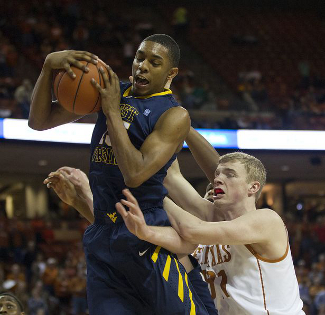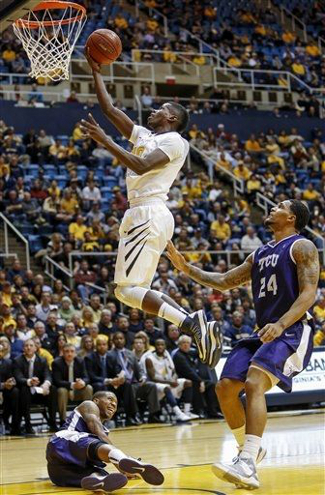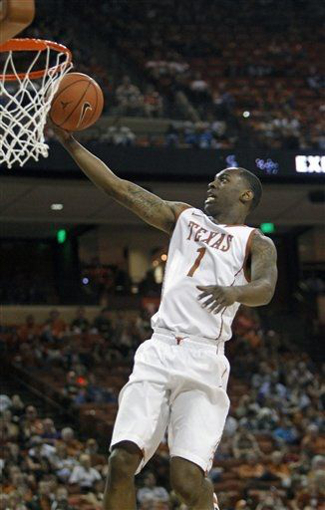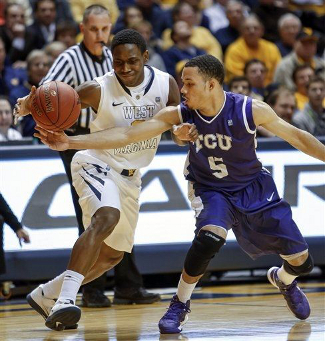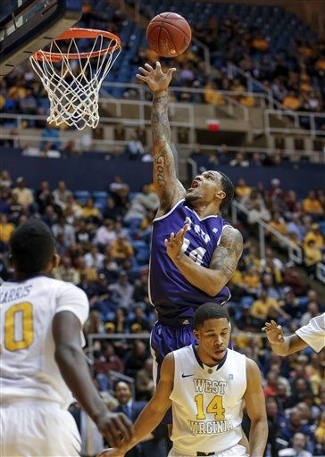Texas Longhorns (9-10 overall, 1-5 Big 12) at #18/21 Kansas State Wildcats (15-4, 4-2)
Bramlage Coliseum | Manhattan, KS | Tip: 7 P.M. CT | TV: ESPN2
LRT Consecutive Game #240
The Texas Longhorns finally earned their first conference win on Saturday night, taking care of a Texas Tech team that should finish the season at the bottom of the Big 12 standings. Texas looked rejuvenated, hustling to loose balls and pressuring the Red Raiders into mistakes. While excitement was certainly tempered by the quality of opponent, geting over that hump and finally earning a league win was a big accomplishment for this young team. After three narrow losses in Big 12 play and a heartbreaking loss to UCLA in the non-con, the win was a much-needed boost of confidence.
With four games still remaining until the return of point guard Myck Kabongo and with Jonathan Holmes out at least three weeks with a broken bone in his hand, the young Longhorns face long odds in trying to climb back towards .500 in league play. Increasing the difficulty level are a pair of tough road trips over the next week, as the Horns head to Kansas State tonight and West Virginia on Monday. Although Texas is just 1-8 away from the Erwin Center and winless in true road games, stealing a victory in either one of those games would go a long way in the team’s fight to get back to the middle of the pack.
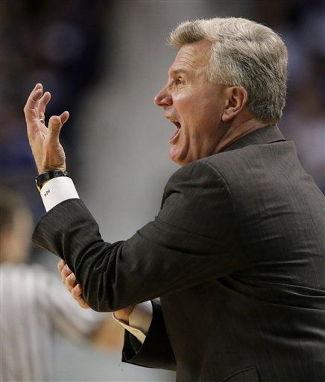
The Wildcats haven’t missed a beat under Bruce Weber
(Photo credit: Charlie Riedel/Associated Press)
Kansas State poses an especially tough test, as their experience far outweighs that of the Longhorns. The Wildcats return essentially everyone from last year’s NCAA-tournament team, having lost only Jamar Samuels and little-used Victor Ojeleye to graduation. Texas has also come up empty in its last two trips to Bramlage Coliseum, while K-State has won 11 out of their last 12 games at the Octagon of Doom.
By the numbers
With almost the entire K-State roster back, it’s no surprise that the team has maintained its stingy defense from the Frank Martin era. On the season, the Wildcats are allowing an adjusted 0.902 points per possession, according to Ken Pomeroy. The Wildcats force mistakes on 22.4% of their defensive possessions and have held opponents to a 46% effective field-goal percentage, both stats that rank in the Top 100 nationally.
However, when you dig a little deeper into the numbers, it’s clear that K-State’s defensive stats have been buoyed a bit by a very strong start against weak non-conference competition. Since the start of Big 12 play, Kansas State’s adjusted defensive efficiency has ballooned to 1.001 points per possession. League opponents have an effective field goal percentage of 49.8% and a free-throw rate of 44.8%. In simpler terms, Big 12 foes are getting to the line to shoot a little more than two free throws for every five field goal attempts.
Another K-State statistic that has seen a precipitous drop since the start of league play is their offensive rebounding percentage. For the year, the Wildcats have reclaimed 39.1% of their missed shots, but have been able to do so only 27.8% of the time against Big 12 opponents. In fact, in Saturday’s loss to Iowa State, KSU posted just a 17.2% mark on the offensive glass. The Wildcats are only an average-shooting bunch, having an effective field goal percentage of 47.7% on the year. That means that offensive rebounds are essential for K-State to keep scoring, so the drop-off in league play is concerning.
The other reason that the Wildcats are able to have an efficient offense despite average shooting is the fact that they value the basketball. Kansas State has a turnover percentage of only 18.9%, and the team has improved that to 17% against Big 12 opponents. Their ability to maximize possessions by not turning it over and getting to missed shots is the reason that their adjusted offensive efficiency is a solid 1.062 points per possession.
That offense has a new look under first-year head coach Bruce Weber. He favors a motion offense with constant cutting across the free-throw line and baseline, eschewing pick and roll sets for dribble handoffs and crisp passing. As a result, the Wildcats have assists on nearly 65% of their buckets, a number that ranks 11th in the nation. That stat also underscores the fact that it can be hard for K-State to score if it doesn’t get looks in the flow of the offense. The team lacks true slashers that can get to the rim or players that can shake a defender to get an open jumper.
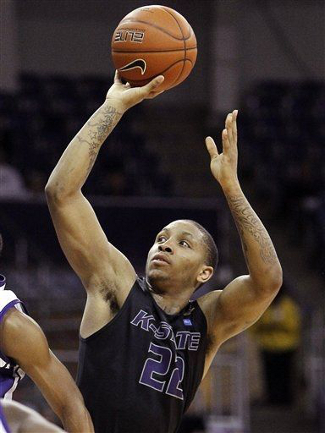
Rodney McGruder is the senior leader for K-State
(Photo credit: Brandon Wade/Associated Press)
That reliance on taking jump shots off of passes also means that the Wildcats don’t get to the line very often. The team’s free-throw rate of 32.3% is ranked in the bottom 100 of Division I’s 347 teams, but that could be a blessing in disguise. When the Wildcats do manage to get to the charity stripe, they make only 64.7% of their attempts.
Meet the Wildcats
The team’s leading scorer is senior Rodney McGruder (No. 22), a player that Texas fans know all too well. In last year’s meeting at Bramlage Coliseum, McGruder poured in 33 points, and he has averaged 19.3 points in four games against Texas. There were some growing pains for the senior at the begining of the season, as he adjusted to his new role in Weber’s offense. Now, he is much better at reading the defense on his cuts and finding open space to receive the pass and get up his shot. McGruder is averaging 18.7 points and has made 44.2% of his threes in Big 12 games.
Whoever is tasked with slowing down McGruder will have to bring their track shoes. The Wildcats will run their star through numerous screens, waiting for just enough of a defensive lapse to get him open for a jumper. If Julien Lewis and the other Texas defenders can stay in McGruder’s shirt and force him to put the ball on the floor, his effectiveness is limited. He has shown at times this season that when opponents deny him open looks on the pass, he can get frustrated enough to start forcing bad, challenged shots off the bounce.
As of late, the other main scoring threat for Kansas State is junior Shane Southwell (No. 1). After coming off the bench in the team’s first nine games, Southwell has been a starter in the last ten. In Big 12 play, he is averaging 11.8 points and has knocked down 48% of his threes. He is a skilled shooter who has a nice midrange jumper, but he is perhaps most dangerous when opponents switch on screens. The 6’6″ Southwell is quick to notice when he has a smaller guard on him, and will isolate those defenders near the hoop for short jumpers and layups.
At the point, sophomore Angel Rodriguez (No. 13) has grown up quite a bit since last season. In the team’s last four games, the once-erratic Rodriguez has posted 26 assists against only three turnovers. For a player that would often over-penetrate and force the ball against set defenders, that improvement is staggering. He still can get defenders on his hip and drive to the rack, but now the sophomore has a better feel for when those opportunities are actually there.
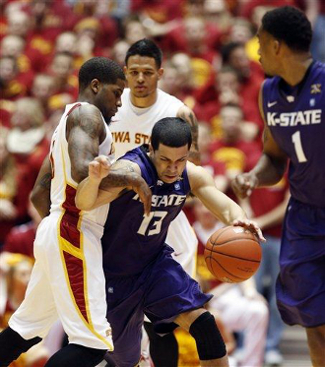
Angel Rodriguez has drastically reduced his turnovers
(Photo credit: Matthew Putney/Associated Press)
Unfortunately, while Rodriguez has been improving his ball control, his long-range shooting has declined considerably. The Puerto Rican product certainly has range beyond the arc, but he has made only 6-of-28 (21.4%) in the team’s last ten games, dragging his average down to 29.6% on the year. While the Longhorns can’t completely sag off of him, his long-range struggles do mean that they can give him a little space and try to neutralize his driving ability.
In the middle, sophomore Thomas Gipson (No. 42) is a vacuum that keeps the K-State offense humming. Although the Wildcats don’t typically post him up and dump the ball inside, he constantly reclaims missed shots and knows where to go when Rodriguez drives so that he can receive the dump-off and go up strong. Gipson’s offensive rebounding mark of 15.9% is 21st in all of D-I hoops, while his 17.3% mark on the defensive end also ranks just outside the Top 400.
One issue with Gipson’s game is his inability to convert at the line. Although K-State doesn’t get to the stripe very often as a team, he draws a little less than six fouls on opponents per forty minutes. That sends Gipson to the free-throw line around four times per game, where he is only making 57.4% of his attempts.
Rounding out the starting five is three-point marksman Will Spradling (No. 55). Like McGruder, Spradling will have numerous screens set for him in the K-State motion offense, and he has the quick release and accuracy to make opponents pay. On the year, he has made more than 35% of his threes, and has taken more than 67% of his looks from behind the arc. Although the Longhorns are already going to have their hands full trying to shut down McGruder and Southwell, they also cannot afford to lose track of Spradling.
With conference play now in full swing, Coach Weber has shrunk his core rotation to eight players. Senior forward Jordan Henriquez (No. 21) is a familiar face to fans of Big 12 basketball, as his 6’11” frame has made him a defensive presence all four of his years in Manhattan. He has a lot of length — even for a guy that tall — and has great timing, making him a great shot-blocker in the middle.
It’s also worth noting that when Henriquez gets the ball in the post, teams might actually find success simply fouling him. The senior has made just 28.9% of his free throws this year, and is a 50% career shooter at the line.
Fellow senior Martavious Irving (No. 3) plays an important role as the team’s backup point guard, and also brings excellent perimeter defense to the table. Irving is also a threat to pop the three, and has shown no qualms about quickly taking one off the dribble when opponents are paying too much attention to McGruder and Spradling off the ball.
Sophomore forward Nino Williams (No. 11) was a highly touted recruit out of high school, but never found consistent playing time under Coach Martin. He is still just a role player at this point, but is now at least seeing the court every night and averaging 12.5 minutes per game in league play.
Although not a part of that core rotation, freshman forward D.J. Johnson (No. 50) could also see some meaningful minutes in this one. After hardly playing from mid-December to late January, he logged 20 minutes against Iowa State on Saturday and chipped in a block and two boards. At 6’8″ and 250 pounds, he already is an intimidating presence inside, and it looks like he can be a force in the Big 12 by the time his career is finished.
Keys to the game
1) Limit KSU’s offensive rebounds – Closing out defensive possessions with rebounds has been a problem for Texas all season, and that could unfortunately play a huge role in tonight’s game. The Wildcats are generally an average team when it comes to shooting the ball, but they crash the glass and earn second-chance points. The Longhorns allowed a smaller Texas Tech team to reclaim more than 48% of their missed shots on Saturday, and late-game offensive rebounds helped Baylor and West Virginia pull out overtime wins over Texas. Repeating those same mistakes tonight will eliminate any hopes of a Longhorn upset.
2) Communicate on defense – With the constant screening and cutting in Kansas State’s offense, the strong Longhorn defense is going to be tested tonight. Texas needs to recognize who the shooters are and avoid going under screens against them, while also being aware that players like McGruder and Southwell will exploit favorable matchups that can arise from switching screens. If Texas can play sound team defense, the score will be in the range that can give them a shot at pulling off the road win. If not, this Wildcat offense can make their half-court offense look like a clinic.
3) Take care of the basketball – The opening ten minutes of the Oklahoma game and the final minutes of the Kansas loss reminded Texas fans just how bad the turnover bug was for the Longhorns at the beginning of the year. While the youngsters have made vast improvements in that department, the hiccups tend to come back in waves, and often at the worst possible time. Kansas State forces quite a few mistakes with their defense, so the Longhorns must avoid coughing it up tonight. Not only will turnovers waste possessions, but they will often lead to runouts that will get a loud and intimidating Bramlage crowd whipped into even more of a frenzy.
| 







